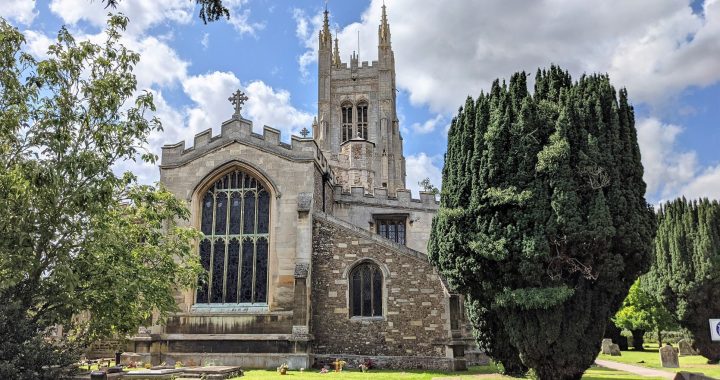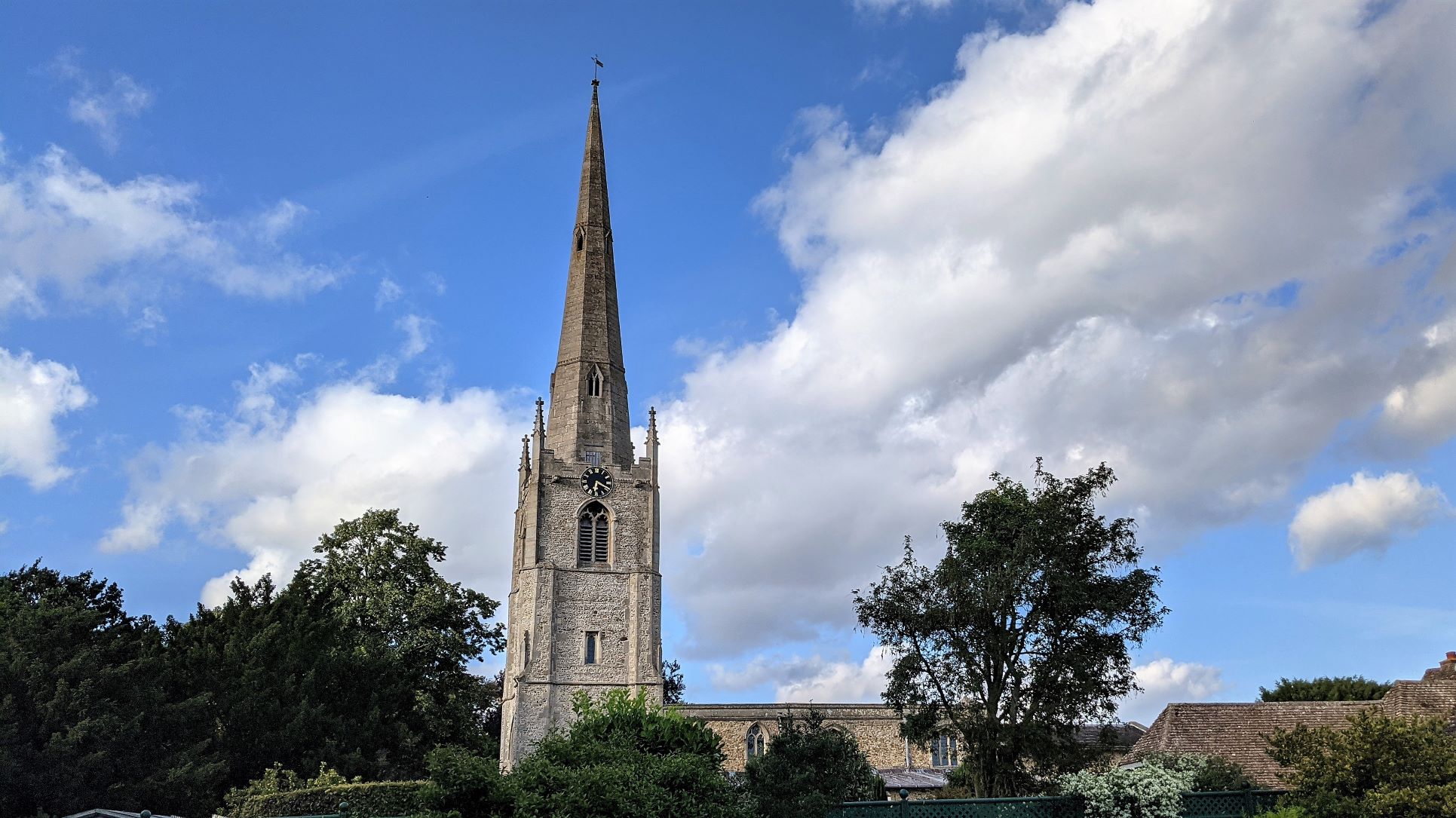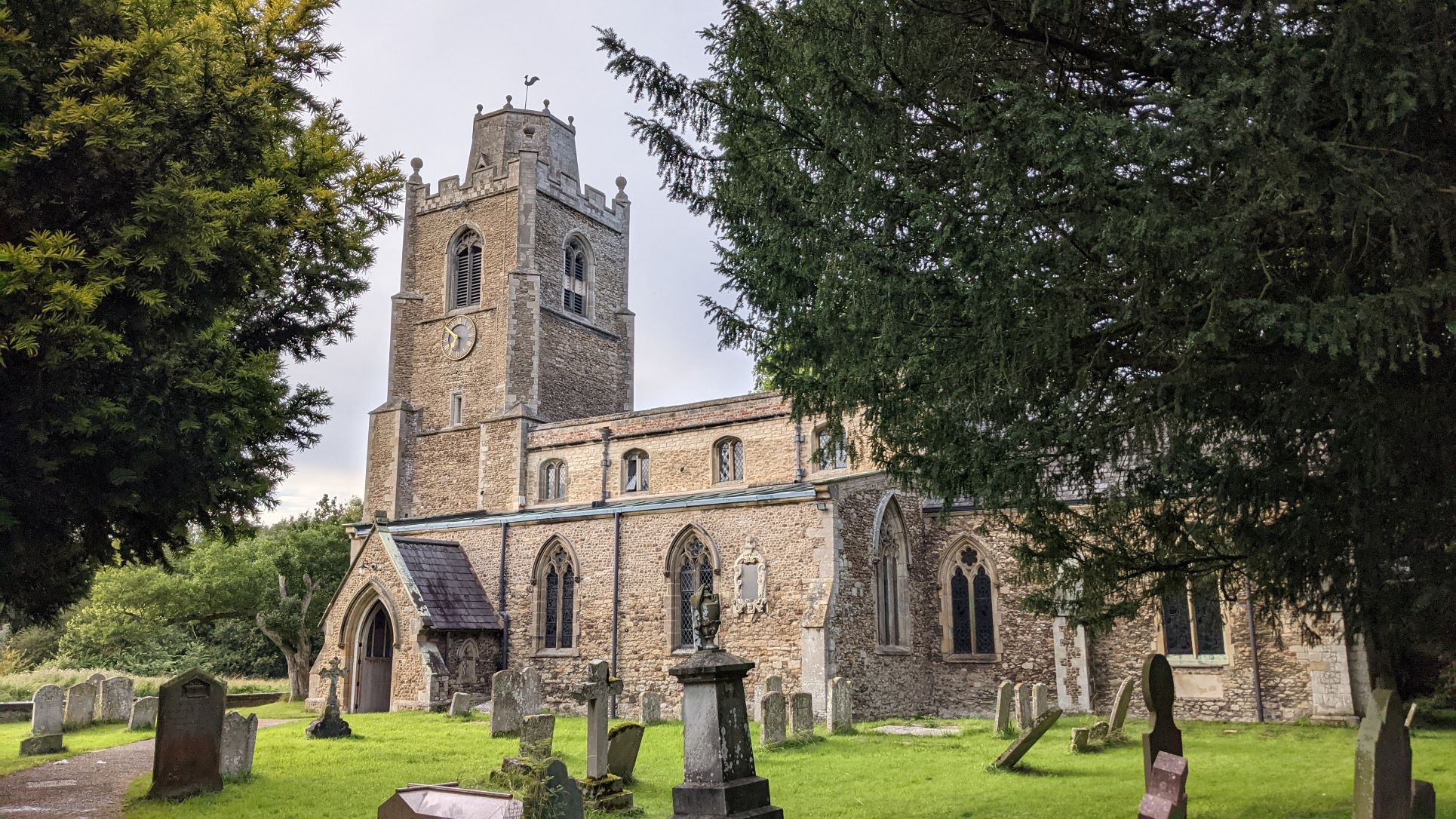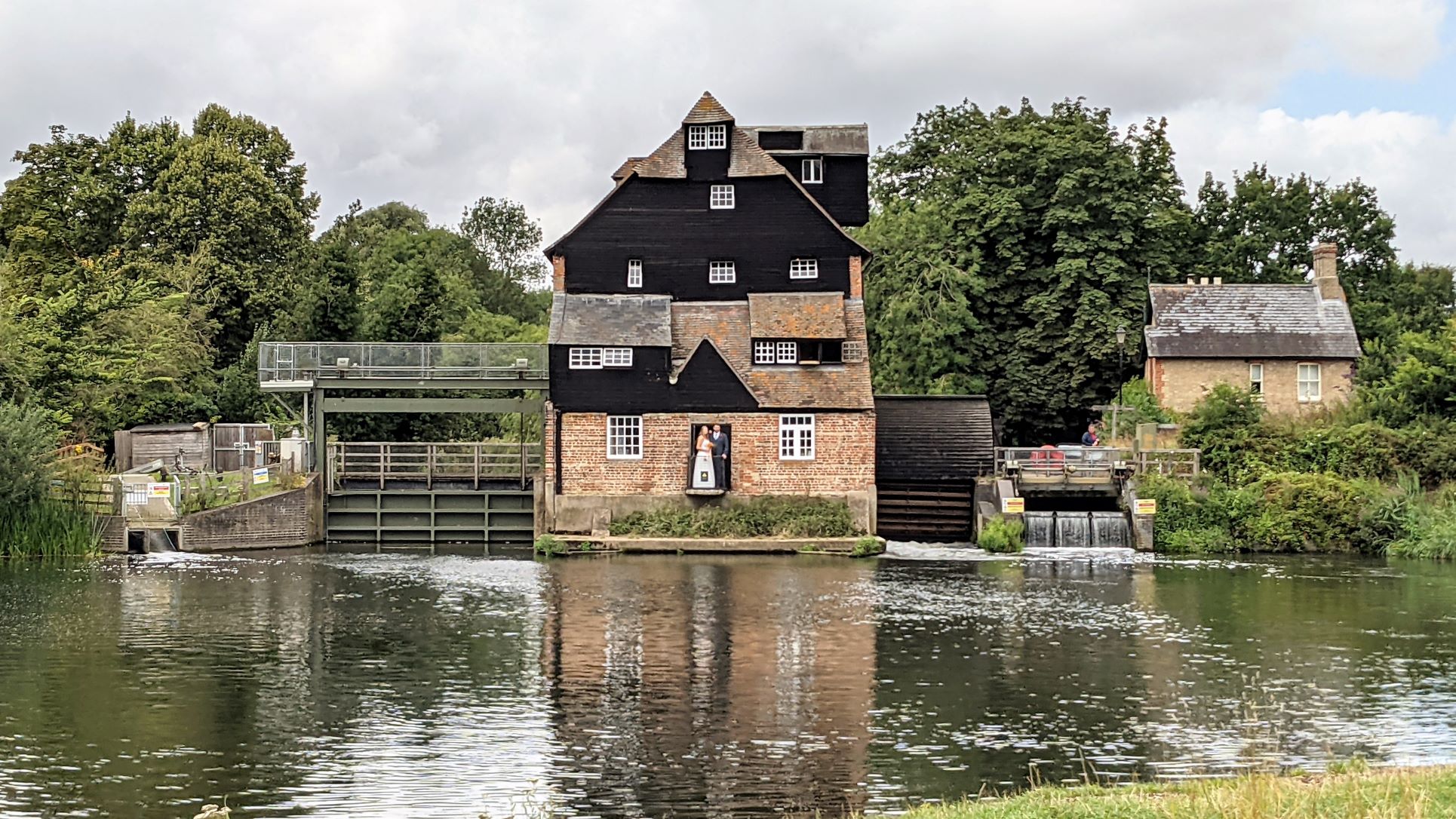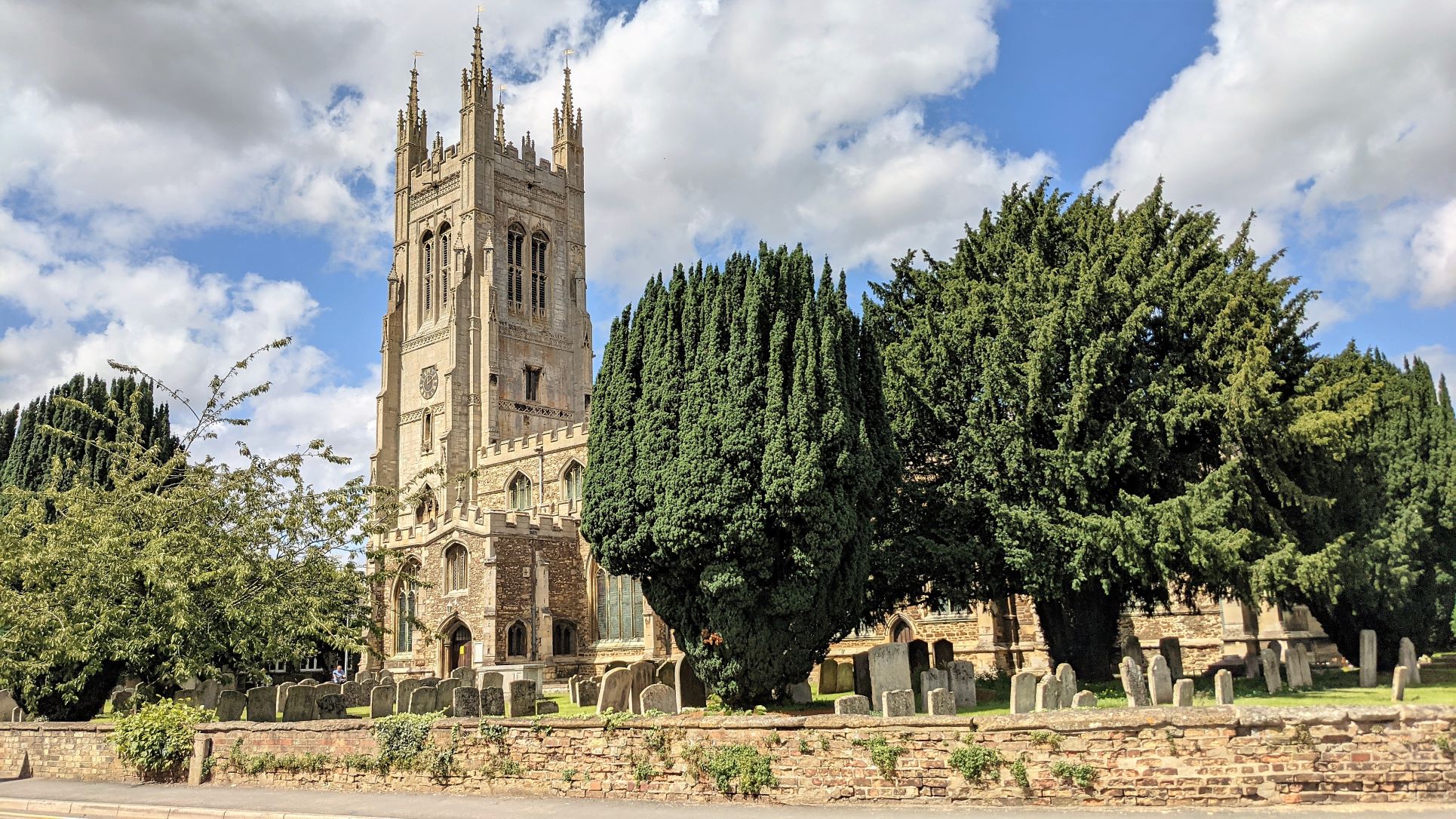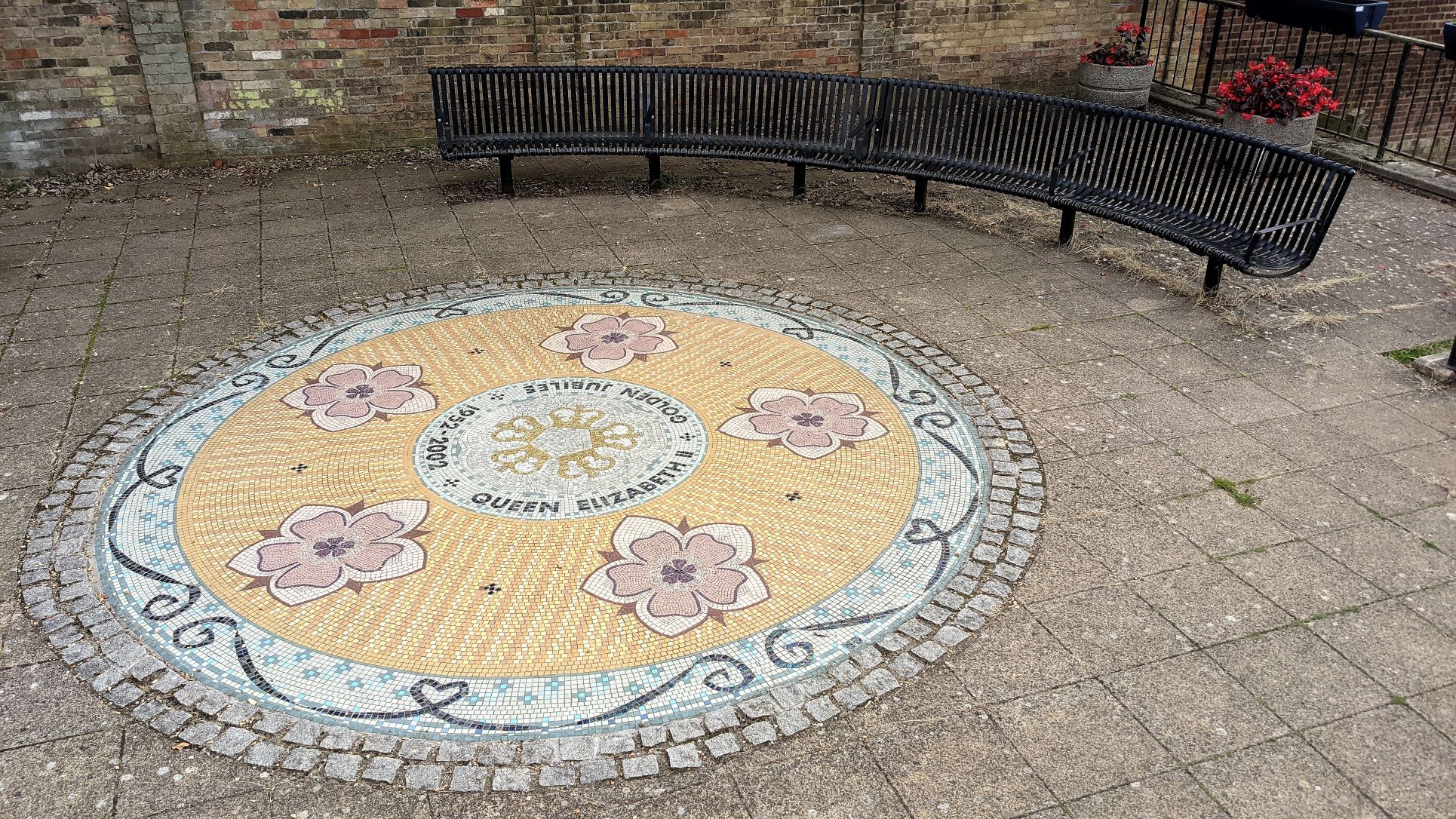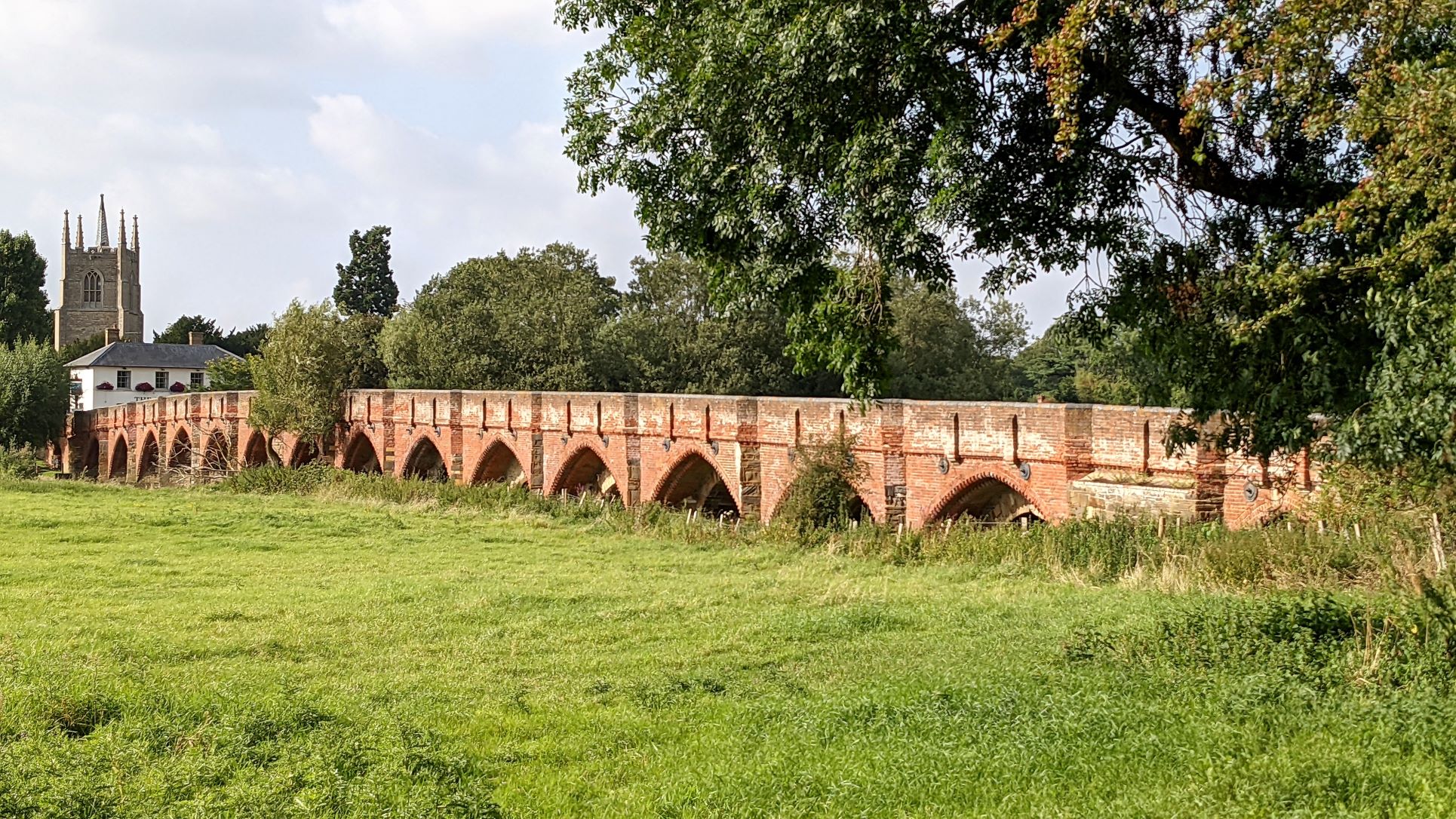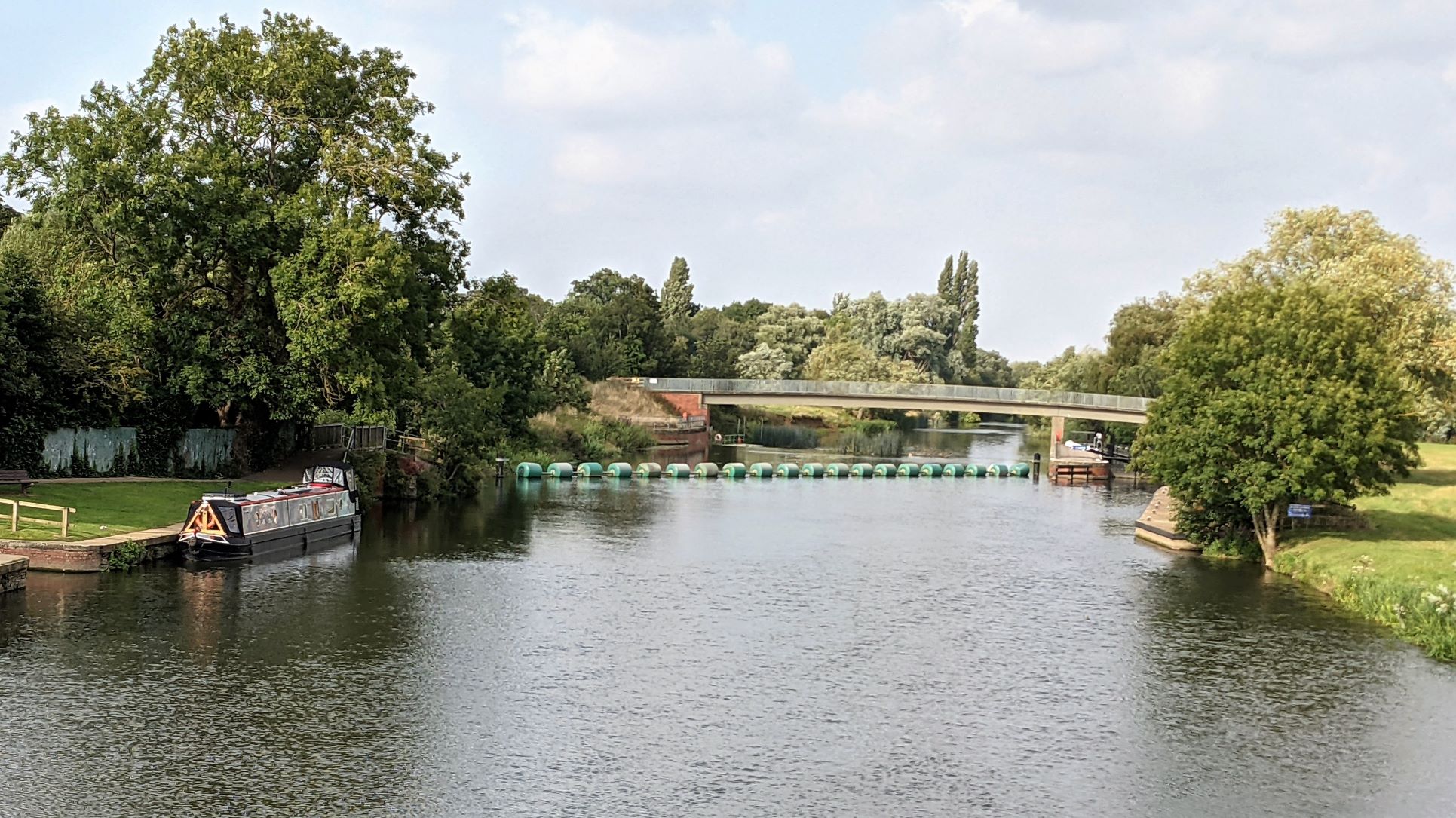Way Out On The Old West
Before setting out on Tuesday we had to attend to our services again. It was very busy with boats up and down the river all the time and we ended up having to assert ourselves as being in the queue or we would have been there all day. In the excitement of at last being ready to leave Sue tripped over a rope and fell flat on her face. This only happens when she judges that there is a large enough audience to come to her aid but to her credit, she never let go of the centre line.
There was no harm done and we finally set off about noon. The wind seemed to be moderating, at last, perhaps just because there were increasing numbers of trees along the banks. A generally fine day and a hot, sunny afternoon played its part in improving our mood.
The river stayed wide and open as we approached Pope's Corner where, although it appears to continue straight on, The Great Ouse actually turns right. The continuing broad stretch ahead is, in fact, the River Cam. The Great Ouse changes character completely shortly after the turn. At the junction it becomes known as the Old West River and its appearance and width are steadily scaled down so that it looks quite similar to a canal, or at least parts of the River Nene.
Similar to Friends Of The River Nene there is a group called the Great Ouse Boating Association who have set up and maintain small moorings up and down the Great Ouse. Of course, we had handed over our joining fee and today we were targeting one of their sites for an overnight stop for the first time. We found GOBA Aldreth easily enough and it was empty of other moorers. However, one half of it was very much occupied by cows and the whole length was obviously prone to flooding. We did find a spot that was relatively dry and cattle free and settled ourselves in.
Aldreth, itself, is a hamlet about a mile from the river but the only route to it was a long loop of about three and a half miles. I needed some exercise so I went and had a look at the place. It was a nice enough collection of houses, some of them quite new but all individual and in good taste, by and large. It is rather unusual in having no apparent church or chapel of any kind or denomination, as well as no shops and no pub. You might almost think that it was a recent creation but it certainly goes back to Norman times and is thought to have been the scene of two battles between Hereward The Wake & William The Conqueror.
As I Was Going To St Ives . . .
Leaving Aldreth behind we had a fine, sunny day with light winds, so perfect for cruising. At the end of the Old West River is Hermitage Lock. Beyond this lock the entrance to the New Bedford River lies on the right with the Great Ouse turning left, now tidal again until the next lock, Brownhills. All the water of the Great Ouse and its tributaries above Hermitage Lock is directed down the New Bedford River. There are no other water sources for the Great Ouse on the Old West River section other than what is allowed through Hermitage Lock during its operation.
This lock is also manned, so we had to phone a number and let them know we were coming. A simple Red / Green traffic light system tells you whether you can proceed into the lock or not. Our call went straight to voicemail, so we left a message that we were on our way in. No-one called back but just as we approached, the light turned Green. It is pretty clear that they never answer the phone, just hear the message and let the lights serve as their acknowledgement. Once we were inside the lock keeper appeared and gave us what little guidance was needed.
Emerging from the lock we were immediately back on the wide, open river. Not as bleak as the fens and with much wider views but making us feel quite exposed. On a day like today it was no threat at all but it was obvious that you would need to take great care when the waters were running high. As it was there was a freshening breeze and it had full rein across the open water.
This tidal stretch runs up to Brownshill Staunch, another big weir with a lock beside it. This one is unmanned but like the last two, the lock chamber is very long and we needed to work out how best to secure the boat, with only one person on board, before the water starts pouring in. Here at Brownshill it seemed to work alright with Sue holding a centre line looped over a bollard on the lock side.
We carried on up to St. Ives Lock, where things did not go quite so well. Firstly, we had not appreciated that this was a 'D' shaped lock and what that entailed. Effectively, it means that there is a cut-out in the lock side that is large enough to accommodate one boat. It is possible, therefore, to fit three quite large boats in at the same time. We arrived at the lock landing and before we could think about what was involved "Plan B" arrived, a large cruiser. They went in and occupied the 'D' section and we came in after them. We got the centre line looped on and back to Sue, at which point someone who had arrived and was waiting to come down the lock threw open the paddles on the top gate as fast as they could. The rush of water coming in set our boat surging around in the open lock with Sue hanging on for dear life. In the end, the current was too strong and she had to let go leaving the boat to bob about out of any control. Fortunately, by then, the lock was partly filled and there was no real harm done but it was alarming.
Having caught our breath we carried on to the Town Quay at St. Ives, which was full and then, avoiding a head-on collision with another narrowboat coming downstream, at speed, through the single navigable arch, we passed through the bridge and checked out The Waits mooring. This is a single channel with space for five or six moored boats on the right and for one boat to pass alongside them. I had not done enough research for this part of the trip and didn't realise what we were getting into. All the spaces were full, most with their crews on board drinking in the sunshine and a variety of alcoholic beverages. Interestingly, no-one thought to say anything as we glided past. I hoped that the channel would go straight through and back out onto the river. In fact, it was a dead end, although the map did show a winding hole at the end. When we got to the end, however, the space that was probably intended for this purpose was more like a swamp. Overgrown with trees, silted up with very obvious mud banks and impeded by a sunken boat, loosely tied at the side, there was no way to turn a sixty foot narrow boat there. We had no alternative but to start reversing up the way we had come, past all the moored boats, including one wide beam. It went surprisingly well, helped by being in the lee of a large stand of trees. There was one tricky moment as we cleared the channel and were suddenly exposed to the full force of the wind but we had cleared just enough room to be able to use more power from the engine to exert some control.
There were two other moorings in the town and we could see they, too, were full but the GOBA came to our aid. They had established a site on the river bank, outside the town but just a few hundred metres upstream. This was busy too but we managed to find a space to squeeze into. On foot, just across the meadow, there was a path back into town, which was only a ten minute walk.
Having lived in this area for a few years, a long time ago, it was interesting to see the town again, with what was familiar and what had changed. We stopped off at Floods for a drink before dinner. This used to be quite the place to go in St. Ives, with a popular bar downstairs and a very nice restaurant above. It is rather different now and it is hard to judge how much to attribute to the impact of Covid and how much to a general decline. I enquired about the restaurant and it is still up there but only opens up on weekends. The downstairs space was filled with tables with chairs stacked up on them and was clearly not in use. Outside, they had established a temporary bar area and opened up a terrace down to the river wall, which was quite pleasant in the sunshine. Less pleasant was standing, trying to order a drink from the barmaid, while another staff member stood beside me lobbing bottles over my shoulder into a bottle skip behind the counter. Those that landed made plenty of noise but not nearly as much as at least two that missed. A venue no longer on our recommended list!
Pastures Old
From this point we would be travelling through an area that we should be expected to know well. We spent about seven happy years living in Godmanchester, near Huntingdon. Most of the places we would pass through, now, would be considered local, at least as far as St. Neots. We thought it would be interesting to see how much things had changed. In practice it was almost more interesting to see how little we remembered or how different things seemed from the perspective of the river.
Leaving St. Ives the next stop was The Hemingfords, one lock and less than an hour up river. Fine, dry weather continued but the wind was stronger than ever. There is a town quay at Hemingford Abbotts, which is actually quite sheltered. However, when we moored up there, we found that it was very high. A real scramble up via the roof to get on shore and quite a rough concrete side for the paintwork. Just beyond there was a GOBA site along the meadow between the two villages and we moved up there. It was a mooring that suited us better and there was a space available but it was very exposed. Approaching the mooring we were blown right over on to the far side and had a bit of manoeuvring to get across to the bank in a lull between gusts. Having managed to get onshore with a centre line I would normally pull the boat in to the side for Sue to then hold while I put in the pins. Here, with nothing to secure it to, I couldn't even hold it on my own. Even when Sue got off to help, we could hold it where it was but just couldn't bring it in to secure it. Another boater sitting near by came and gave us a hand. With his help we got the boat alongside and I was able to get it pegged in but it was an impressive demonstration of the power of the wind.
Hemingford Abbots and Hemingford Grey are two small villages adjoining along the river between St. Ives and Huntingdon. When we lived up here we would walk along the river past them and admire the pretty, unspoilt cottages and larger, grander houses of what were two of the most expensive locations in Cambridgeshire. One of them was regarded as being superior and more exclusive than the other but that was only a question of degree. At this remove, I can no longer remember which was the poor relation to the other and with fresh eyes I could see very little to set them apart.
A stroll around both settlements later in the afternoon showed that they were as privileged and chocolate-box perfect as ever. There was a little extra development around the edges, perhaps, but no acres of new housing estates. In the older parts, down towards the river, every property was pristine; well-maintained, smartly decorated and tightly clipped. As I passed one house, there was a lady out on the front lawn tidying up some blemish, invisible to the untrained eye, with a dustpan and brush. Each village has its pub and each was fully operational with prices clearly reflecting the wealth of the inhabitants. At The Cock, for example, nine pounds for a perfectly ordinary fish finger sandwich, however elegantly described, seemed excessive to the point of extortion. Needless to say, we passed. However, we did go across to the Axe & Compass in Hemingford Grey for a drink in the windy sunshine.
The next day promised the same high winds so we decided to stay put. We went for a long walk across to St. Ives and around on the other side of the river to return across Houghton Lock and the Black Bridge. We had a longer look around St. Ives and the mix of the familiar bones of the place, overlaid with thirty-five years of modernisation and growth was really quite strange and disconcerting. There is no doubt it is now, as it was then, an attractive little town to live in but it is much livelier now, with a lot more bustle and a catalogue of High Street names that we once would have expected to have to go to Cambridge to find.
The old path that runs above the river all the way to Houghton is now clean, dry tarmac all the way. We took a footpath off that which follows the actual river bank, no doubt prone to flooding in winter but quite dry, if a little overgrown, in August. From the bank you can get a different view of the Hemingfords and it brings you out at Houghton Mill. A mill stream runs off the river and the mill stands over it, of course, with the village a few hundred yards inland. It is a fully restored, eighteenth century, flour mill now owned by the National Trust and there is a large car park and picnic area as well as a café. Lots of people use the water downstream from the mill for canoeing and paddle boarding and Houghton Boats are on hand to hire you a canoe, punt or rowing boat. While this was all open and busy we were surprised to find that the mill itself was closed, due to a private function. It seems it had been hired out for a wedding party. We hadn't realised the NT did that sort of thing but I guess they are desperate to find new revenue after COVID. I am not sure where that leaves the members, who have paid their money for free entrance already, in the pecking order.
A look around Houghton and the neighbouring village of Wyton was interesting as well. Although it was only two o'clock on Friday afternoon it was very busy and at the Three Jolly Butchers in Wyton they were turning people away, even if they just wanted a drink. There wasn't quite as much change as in St. Ives but it certainly seemed livelier than we remembered with facilities that never existed when we knew them.
Unplanned Pits Stop
Our two nights in Hemingford were up so we set off on Saturday morning for quite a challenging day. It was dry and sunny, the wind was a bit lighter and we even got some help at Houghton Lock.
The next stop was Huntingdon, the closest big town to our old home but not one we had ever found particularly attractive. It is surprising how little thought we used to give to its position on the river all those years ago. Today we just wanted to stop at the water point shown under the shadow of the town bridge. The wharf there was occupied but with the help of one of the two boats moored there, we breasted up against one of the boats and got the hose out. Looking around for the water tap we finally found it, half way up the slope to the bridge, about thirty feet from the bank. Opening it up we found that it was a basic kitchen tap with a push button top. There was no way of attaching a normal hose to it and having jury rigged something, the flow could only be maintained by pressing and holding down the button, which then delivered a pathetic trickle. Five minutes of that was more than enough. We packed it all away and got going again straight away. We already planned to stop at Buckden Marina for fuel so we would get water there.
We went past our old home village of Godmanchester and through the lock there, again something we hadn't ever given much thought to when we lived there. Brampton Lock was next upstream. We saw that the old mill there, which, all those years ago, had just started to operate as a restaurant and tea room, seemed to have fulfilled its early promise and was now "a stylish pub, for relaxed drinking and dining", clearly flourishing despite the dread disease.
Three and a half hours in we arrived at Buckden Marina, one advantage of which was that they had a service pontoon on the riverside. We pulled in and had to phone to get the attendant to come up from the office. While we waited for him to appear we started the water running, again at very low pressure but at least it could be left running. When they finally arrived we asked for diesel. Our bow was just beside the pump, which was at one end of the pontoon, with a wide beam, permanently moored just ahead preventing us from going any further forward. At this point we realised that the pump hose was a maximum of ten feet long. It was never going to reach our filler cap fifty-nine feet further back. I wondered if he had a solution for this, as surely it must be a frequent problem but no, the answer was not to sell us any diesel. However, he did run me and the cassette down to their Elsan point in his ancient Kawasaki buggy and we did fill up with water, so not a total waste of time. Presumably, this was another illustration of this area being much better adapted to short, nimble cruisers than long, heavy narrowboats.
Fortunately, we didn't need fuel that badly. It is good practice to keep the tank topped up and I always feel that, when using a Marina's services, buying some diesel at the same time is just the polite thing to do. It was also convenient to stop here as there was a mooring clearly shown across the river just below Offord Lock, which we intended to be our home for the night. It was shown on at least two maps, although in slightly different places and marked as EA on one and GOBA on the other. It was a bit frustrating to find no trace of it at either point. Essentially, the land that side of the lock forms a small island that I walked all the way round and found no trace. We had no choice, then, but to carry on up the lock and continue upstream.
There was one other GOBA site shown, about an hour further on. Other than that, we would need to get as far as St. Neots, another hour and a half beyond that. On a hot August afternoon we really didn't want to be going for that long but as we reached the first site we could see it was pretty small, with only room for a couple of boats and that there were two already tied up there, with their crews sipping cold drinks and picnicking on the bank. We cruised slowly past and had resigned ourselves to moving on when, for some reason, I just decided that it might be worth asking the people we had seen if they really intended to stay the night. We were able to take advantage of the wide river to do a U-turn to head back downstream and as we approached the bank, to get close enough to talk, one of the crews called out that if we wanted to moor up they would be leaving very shortly. By the time we had done a second U-turn, to come back up again, they were ready to go. We had a squeeze to get into the space they vacated but the other boat came and helped us to get in. They revealed that, as soon as they had finished their tea, they would be off too, opening up a bit more space. There were three of them, probably in their early seventies. One of them had just bought the boat, a nice little wooden motor launch, that week. He and his two friends were out for a sunny, Saturday jaunt to try it out and enjoy a few drinks on the way; quite a few, by now, we rather gathered. It really was a little like an episode of Last Of The Summer Wine.
Foggy, Compo and Clegg duly departed and we had the place to ourselves. It was a lovely isolated mooring on the banks of Paxton Pits Nature Reserve, a wildlife conservation area and designated Site of Special Scientific Interest rising, like so many others, from the worked out remains of industrial activity. In this case it is gravel extraction that has created the huge excavations that, once the dredgers and draglines had moved on, have filled with water and repopulated themselves with all manner of flora and fauna. The gravel extraction had always been a local activity and had became larger scale from nineteen thirty-nine to provide material for the building of runways in the second world war. The industry still continues nearby and an expansion of the nature reserve is promised for twenty twenty-six as the latest pits are worked out. The mooring was on one of the circular trails around the heronry so we saw some foot traffic in the afternoon but as visitor numbers fell off later in the day we could have our own private tour of the lakes and hides.
St. Neots - Imported Affluence
The next town on our route was St. Neots. This was on the outer limits of our familiar area from Godmanchester. Again, the river hardly featured in our thoughts in those days and as a town our recollection of it is one of its being rather shabby and uninteresting. The name is a great example of religious shenanigans in the early middle ages that would leave today's 'villains' in Financial Services in awe. Leofric, a local landowner in Eynesbury, established a Priory that had the potential to generate considerable income from the visits and donations of pilgrims. However, to attract pilgrims they needed relics for them to make a Pilgrimage to. Leofric arranged for the bones of Saint Neot, a much-revered Saxon monk who had spent his life in Cornwall and been buried there, to be exhumed and brought to Leofric's new Priory. This had the desired effect and the Priory became a major centre of attention for pilgrims and financially, very successful.
Arriving by water, while we were presented with some challenges, it was definitely more attractive with the river being quite wide and passing through the town bridge with the Priory Centre on the town side and a large park on the left bank. It probably just looks better from the river but it has also definitely had some investment in the landscaping and activities in the park. This was very well used and a small orchestra gave an open air concert during the afternoon that a lot of people seemed keen to attend.
We approached St. Neots aware that mooring spaces were limited and more nervous given our experiences in St. Ives and elsewhere. Being a Sunday and reasonably fine we expected to find a lot of day trippers out in their boats for starters. We first hoped to moor a little short of the town, where there was a stretch of council mooring with an open field behind. The mooring was there, clearly marked as such but an angling club had set up shop along the bank, with a fisherman every couple of yards and clearly running a serious competition. Perhaps we should have forced a confrontation but we decided to just move on further towards the town.
There is a pontoon outside the Priory Centre that will take three or four narrowboats and also has the only water point but this was already full. There were a few boats moored on the opposite bank and we went to see if we could join them but found the river bed shoaled badly behind the boats that were there and we couldn't get alongside.
The only other mooring site was through the bridge against the park bank. We crept through and could see that the straight bank available there could take a couple of boats at best and two cruisers were already in place. However, the bank curved round under that side of the bridge and we just managed to reverse into the spot and put our pins in the grass. It was a relief to have been able to find a berth but the difficulty of doing so, especially in town settings, was beginning to make us anxious about what we would find every time we set out. It doesn't add to the enjoyment of the trip.
We had intended to continue on to Eaton Socon where there was access to a large supermarket. However, with concern over getting a mooring on the limited space there, we decided to do the shopping in St. Neots and stay the night here, which would give us time to have a better look around. We tried the Priory Centre, the Tourist Information office and the Library but they were all closed, so we ended up downloading a guide from the internet blog of someone who had visited the town themselves. It wasn't ideal but it gave us a route to follow that would cover most of the ground. We didn't find much to get excited about and found the High Street to be really crowded but we did feel the town was rather nicer than we remembered and could see that it had had some investment. The market square was really quite big and it would be interesting to see it on an actual market day.
One interesting feature we came across was a mosaic in the little Jubilee Gardens beside the bridge on the town bank. It was originally created in honour of the Queen's Golden Jubilee in two thousand and two. As it was about to be installed concerns were raised about the suitability of the adhesives used in conjunction with its intended location so close to the river. The installation was put on hold and the mosaic placed in storage at the firm of a member of the Mosaic Committee, where it lay, forgotten and gathering dust, for seventeen years. A local councillor became aware of its existence and located both the mosaic and the original artist. Suitable materials were able to be identified this time and it was finally installed in two thousand and nineteen. A long wait but a good outcome in the end.
Great Barford Bridge
Monday came with cloudy skies and a return of some seriously high winds. Having checked that the water point was now clear, we had to do a U-turn, dive through the bridge and would have to turn again and go back up through the bridge once we had filled up. In the end the more challenging obstacle was the huge willow tree planted just in front of the pontoon. It was a short jetty with two plastic boats already on it, so coming in completely blind and crouched down to try to get under the branches was not helpful. We managed to stop in time and ended up chatting to a guy called Steve from "Dodgy Dame". He was already using the water tap but insisted we use his hose once he finished to save getting ours out. While we waited another narrowboat arrived and had real difficulty with the wind so that a couple of us had to lend a hand, which made us wonder how our next pirouette would go. There was plenty of width in theory, compared to our boat's length but if you need to use a lot of power in order to overcome the force of the wind you can often find yourself approaching the opposite bank much sooner than you expected. Happily, we made it round with plenty of room to spare and with room to get back under the bridge heading upstream.
We had a little bit of rain and for one reason or another there were delays at a couple of the locks so we arrived at our day's destination shortly after lunch. The sun was starting to come out, there was space to moor and we had a good view of Great Barford's key attraction, which is a Grade 1 listed, fifteenth century and very picturesque bridge spanning the river. The moorings are on a green beside the river that has a water point hidden in the trees about ten yards from the bank and a slipway half way along the mooring area that awkwardly divides the available mooring space in two. The Green is just across the road from the Anchor pub and with a broad area of water formed between the lock and the bridge, this is a very popular place for people to indulge in paddle boarding, canoeing and wild swimming, as well as just wandering around and sightseeing. It was certainly very busy on a Monday afternoon in August but it has to be said that it is also very well maintained and scrupulously clean and tidy.
Once we were settled in I went for a walk across to a place called Blunham. It had a nice looking church but little else to hold your interest and the route back across open fields was now burning hot, so a cool pint at the Anchor Inn was definitely called for. It seemed a nice place and we decided we would return here for a meal on the way back.
The clear afternoon led to a cold night, made more dismal by a couple of hours of very heavy rain from about seven o'clock. We let it clear and got on our way for today's last leg into Bedford. We usually try to avoid going inside marinas just for services. They are generally awkward to navigate, difficult to turn in and tend to have a force ten gale blowing across them at all times. As there are no services in Bedford at all, we would have to stop at Priory Marina, which was not on our list of marinas with bankside service quays, for fuel, water and a sanitary station. For once, though the day remained cool, grey and damp feeling, at least the wind had dropped and so our stop-over was relatively trauma free before we set out after lunch on the final leg to Bedford.
Bewildered In Bedford
The locks seemed to be very hard work on this final day to Bedford and it took us five hours to get there, all told. When we did we found it a rather confusing place to approach from the water.
The town lies beyond Bedford Lock, although there are places to moor just before the lock, including alongside a small park area. These seemed to be quite popular, having a couple of boats moored there. Having passed them we then went under a very low bridge, which rather took us by surprise as it grazed the cover of the top box and so can't have been more than two metres high. There was no warning for it and we concluded that this, together with the lock itself, might be what encouraged people to stop beforehand.
Just beyond this bridge the river takes a sharp ninety degree turn straight into the lock chamber. It is possible that you will find the guillotine gate at the bottom already open. This is a gamble, however, as you can't easily tell and if it is not then you need to pull into the lock landing, which is just before the turn, to go and deal with it. That then makes it awkward to get off the bank and round the bend when you are ready to go through. The top gates open almost directly onto a T-junction with the upper river and there is no lock landing here to allow the crew to disembark or get on board. The right arm goes under Bedford Suspension Bridge to The Embankment but becomes unnavigable in less than half a mile and there are no moorings or facilities in that direction.
Turning left takes you a similar distance to The County Bridge. The head of the navigation is actually at Kempston, two or three miles beyond this, although the Great Ouse runs for a further seventy miles or so beyond that. All the maps and guides show the river as navigable down to Kempston but there are big signs before County Bridge instructing boaters that they should not navigate beyond the bridge. We couldn't find any explanation as to why, other than that there are a couple of very low railway bridges. However, they are not low enough to prevent passage for most vessels and they are not cited as the reason for this injunction.
Just before County Bridge there is a long, thin island on the north side of the river, which separates the main channel from Sovereign Quay. There used to be moorings here but it seems they have been eliminated. However, the water point, which is the only facility provided for boaters in the whole of Bedford, is still sited here, just inside the channel between the island and Sovereign Quay. It turned out that it isn't possible to navigate through the channel and round the upstream end of the island, so a trip to the water point involves backing off and turning round in the river. Access is made slightly more difficult, at times, by virtue of having the Star Rowing Club, one of three operating on this reach of the river, right alongside it and also because the quay is used as the base for the "John Bunyan", a very large trip boat run by the Bedford & Milton Keynes Waterways Trust. The Trust is trying to create a new link from Bedford to Milton Keynes so presumably the trip boat is all part of the fundraising. If they do succeed it would be great news as the journey between the two towns will be cut to around twenty miles, rather than the one hundred and eighty odd miles we had travelled to get here.
The only mooring area left is on the opposite side of the river from Sovereign Quay, outside the offices of Bedford Borough Council and Bedford College. We travelled up stream and turned across the river to come into the moorings, which we were surprised to see were completely empty. They remained deserted for the rest of our stay. Having explored Bedford a little bit further, perhaps it is not so surprising. It does nothing to attract boaters, offers no facilities for them, is awkward to access and is not an inviting place once you are there.
We struggled to find a good guide to Bedford on the internet and any Tourist Information facilities were firmly closed but we managed to download something that took us around the town. After a couple of hours, in rather drab conditions, we were unimpressed. We found the trail and its description rather poor, our progress was impeded frequently by extensive works going on in the centre, the sights we did identify all seemed dirty and neglected and the whole place was rather charmless. We might have felt differently on a sunny day, with fewer pneumatic drills going and a decent guide but I'm not sure that is really it. We have walked round other towns and cities, Chester for example, in the pouring rain and still enjoyed the experience, so Bedford has a lot of ground to make up.

